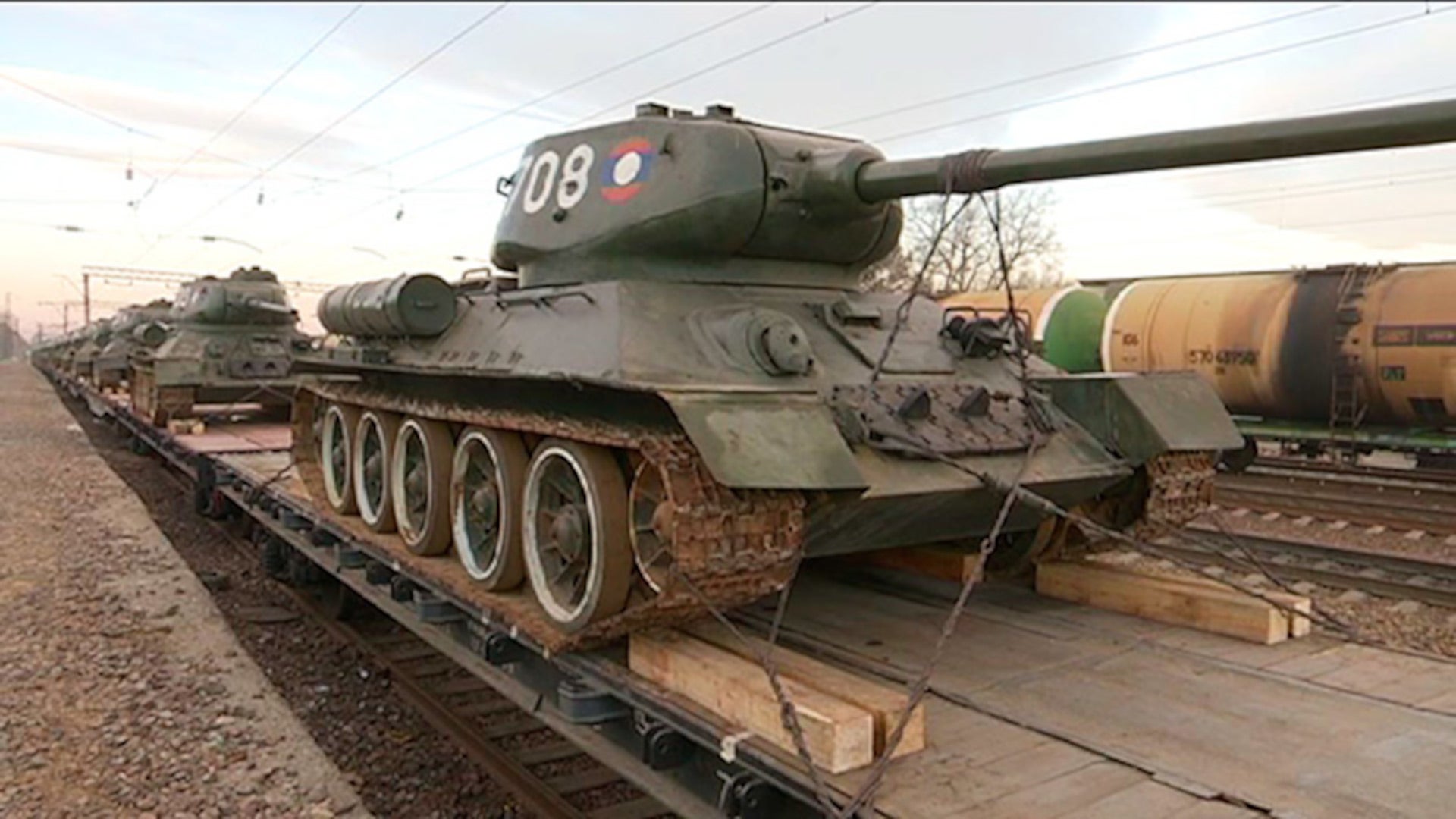In a three-way deal also involving Vietnam, Russia has taken delivery of around 30 World War II-era T-34/85 tanks from Laos. These tanks will take part in public parades, be installed as museum pieces, and maybe even end up in state-sponsored movies and other media. Though the exchange certainly taps into national pride, it may be hard to ignore that the Kremlin looks set to receive more examples of these historically significant, but hardly combat worthy vehicles this year than it will of its new T-14 Armatas.
TV Zvezda, the official television channel of the Russian Ministry of Defense, reported that the T-34s, still bearing their distinctive Lao national insignia, had arrived in Russia’s far eastern port of Vladivostok on Jan. 9, 2019. From there, they will go to the city of Naro-Fominsk, near Moscow, which is home to the Russian Army’s 4th Guards Tank Division.

Pictures had already emerged on social media showing workers loading the T-34s onto a ship in Vietnam on Dec. 29, 2018. Earlier that month, Russia had unloaded an initial batch of T-72B1 White Eagle tanks, bound for Laos, in Vietnam.
Russia introduced the White Eagle upgrade in 2010 and sold the first examples to Nicaragua. These tanks feature various improvements over older T-72Bs, including the addition of the Kontakt-1 explosive reactive armor, a new thermal sight with a built-in laser rangefinder, a remotely operated weapon station on top of the turret, and updated communications equipment.
The Russians reportedly tried to sell Laos the more advanced T-72B3, which feature many more substantial improvements to bring them to a standard close to the more modern T-90, in 2017. That year, Laotian troops had a chance to drive these vehicles during Russia’s annual Tank Biathlon, a sort of hybrid military exercise and sporting event that brings together military personnel from various countries around the world.

Small, cash-strapped Laos balked at the T-72B3’s reported unit price of $3 million, opting for the cheaper T-72B1 White Eagle, instead. The exchange of the T-34/85s was also part of the 2017 deal, according to Russian Defense Minister Sergei Shoigu.
The cost of new armored vehicles has also increasingly been an issue for the Russians, which is only set to begin the final round of pre-production trials of the new T-14 Armata tank later this year in advance of initial production deliveries in 2020. Though Russian officials have downplayed the delays and other issues in getting these new tanks into service, the Kremlin did announce in August 2018 that it would be focusing on purchasing upgraded T-72B3, T-80BVM, and T-90SM tanks in the near-term.
On the other end, Laos appears to have become the last active operator of the T-34/85 anywhere in the world. It’s an impressive run for the last major variant of the iconic T-34, which entered service in the latter half of World War II. As its designation indicates, this version featured an 85mm main gun, which significantly boosted its firepower, especially against late-war Nazi medium and heavy tanks. The tank was already well known for its speed, mobility, armor protection, and reliability, and is generally considered one of, if not the best all-around medium tank of the war.
Between 1940 and 1946, the Soviet Union made more than 58,000 T-34s of all types and after the war, they delivered thousands of these iconic vehicles to allies and partners, where they continued to see active combat. The Laotian examples, which the Russian Ministry of Defense says are 1944 production examples, took a curiously circuitous route to get to that country, though.

Though it has become the final military operator of the type, Laos reportedly only received its T-34/85s as part of an earlier three-way deal involving the Soviet Union and Vietnam in 1987. What was then North Vietnam had taken delivery of approximately 300 of these tanks between 1955 and 1960, according to data from the Stockholm International Peace Research Institute, or SIPRI. Still, the Lao People’s Liberation Armed Forces put these World War II-era vehicles into service alongside its only slightly newer T-54/T-55 tanks, which it had obtained in the 1970s.
With their 1944 production dates, it is very possible that these tanks saw combat on the Eastern Front during World War II. After delivery to Vietnam, they could have seen further action against South Vietnam and its U.S. allies, or against the Americans and their partners in neighboring Laos. That they’re now back in Russia means they’ve come full circle.

They’ve also returned home at a time when Russia under Vladimir Putin has been steadily looking to revise and leverage the history of the Soviet Union to tap into nationalist fervor. Post-Soviet Russia has found itself increasingly the target of international criticism and scrutiny since its illegally annexed Ukraine’s Crimea Peninsula in 2014 and began actively backing separatist movements opposed to the government in Kiev.
Since then, Russian forces have also supported Syria’s brutal dictator Bashar Al Assad in the civil war in his country and have engaged in a growing array of malicious activities around the world, including meddling in foreign elections and attempting to assassinate defectors and other political opponents, often with success. International condemnation of these acts, along with international sanctions, has only prompted Russia’s increasingly dictatorial President Putin to adopt even more aggressive stances.
Weaponizing history, especially with regards to periods of time that many Russians see as high points in the country’s international standing, has become an important tool for the Kremlin. Though the exact timing appears to have been a coincidence, given that the deal with Laos dates back to 2017, the T-34s did arrive in Russia just as a state-sponsored film centered around a T-34 crew broke box office records in the country for a domestically produced movie.
The film, simply titled T-34, took in more than $10 million in ticket sales in its opening weekend. The movie follows what do not appear to be specifically Jewish Russian soldiers in a concentration camp. It is true that Soviet troops suffered hellish conditions at the hands of the Nazis, but the Soviet Union, and now Russia, have also routinely used that reality as a way to downplay the especially horrific experience of the Jews during the Holocaust.

In the film, which came out around the beginning of the New Year, the Nazis force their captives to repair and then drive an unarmed T-34 so that their own tankers can practice against a “live” target. Needless to say, the Russians get the drop on their captors and use the tank to escape “in an attempt to preserve his life, love and devotion to the Motherland,” according to a statement from Russia’s Ministry of Culture.
Early in November 2018, Russian theaters began screening Crimean Bridge: Made with Love!, a romantic comedy that focuses heavily on the Kremlin’s bridge from Russia into occupied Crimea. On Nov. 25, 2018, this structure became the scene of a violent skirmish between Russian and Ukrainian naval vessels.

Holiday, sometimes also translated as Celebration, a black comedy set against the backdrop of the Nazi’s devastating multi-year Siege of Leningrad, which did not glamorize the Soviets, also came out around New Years. However, this privately-funded film has only gotten a Russian-language release through YouTube after falling afoul of the Ministry of Culture.

Though property of the Russian Ministry of Defense, it is almost certain that the T-34s will end up in future state-supported movies, as well as make an appearance at other events. Russia also says the vehicles will allow them to rehabilitate various outdoor monuments and indoor displays.
Some of the tanks will likely appear during the annual Victory Day celebrations on May 9, which commemorate the Soviet Union’s defeat of Nazi Germany. They could easily make appearances at events marking the anniversary of other notable World War II engagements, such as the massive running tank battle near Kursk between July and August 1943.
Whatever happens, that these tanks are still workable after 75 years is a testament to the durability of the design. They’ll likely continue to take part in parades and other non-combat activities for years to come.
Contact the author: jtrevithickpr@gmail.com
